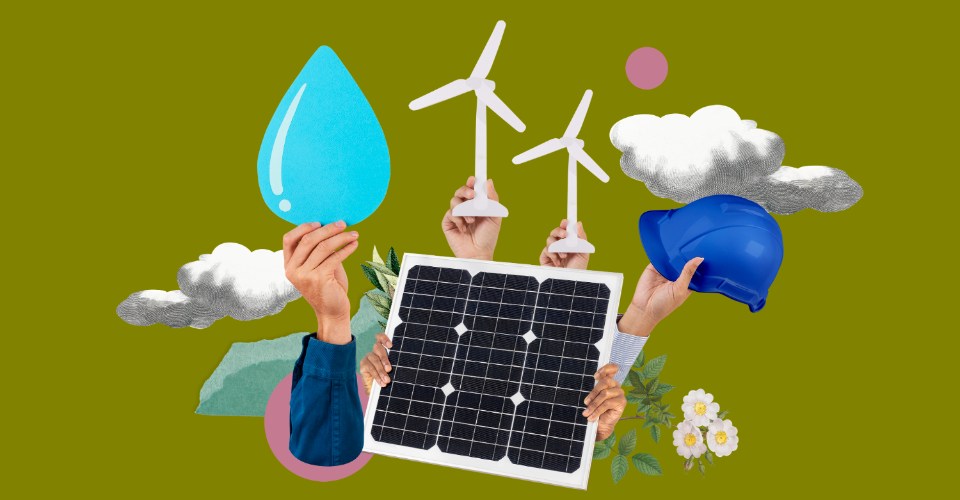A New Hope for Our Planet
Imagine a world where technology not only drives innovation but also nurtures the planet we depend on. In our quest to combat climate change, blockchain technology is emerging as an unexpected hero. Once known for its association with cryptocurrency, blockchain is now becoming a powerful tool for environmental sustainability. With its decentralized nature, blockchain can track carbon footprints, optimize renewable energy usage, and create a transparent, sustainable economy. In this article, we’ll explore how blockchain is paving the way for a greener, more sustainable future.
Understanding Sustainable Blockchain and Its Environmental Impact
Blockchain technology is more than just the backbone of cryptocurrencies. Its inherent transparency and security offer transformative possibilities for tackling environmental challenges. Let’s break down the core aspects of how sustainable blockchain can help reduce carbon emissions, promote eco-friendly practices, and ensure a greener future.
What is Sustainable Blockchain?
Sustainable blockchain refers to the use of blockchain technology in ways that minimize environmental impact while driving sustainability. It involves the adoption of eco-friendly consensus mechanisms like Proof of Stake (PoS) instead of Proof of Work (PoW), which are energy-intensive. Sustainable blockchain also involves integrating blockchain into carbon tracking, waste management, and renewable energy trading systems.
How Blockchain Supports Environmental Sustainability
Blockchain technology can drive sustainability across various sectors by ensuring transparency, accountability, and efficiency. Here are a few key ways blockchain is being utilized:
- Carbon Tracking: Blockchain enables precise tracking of carbon emissions, helping organizations and governments meet environmental targets and verify carbon credits.
- Renewable Energy Trading: With blockchain, individuals and organizations can trade renewable energy directly, ensuring more efficient and widespread use of clean energy.
- Supply Chain Transparency: By using blockchain to track products from origin to destination, businesses can ensure that their supply chains are sustainable and ethical.
1. Blockchain’s Role in Reducing Carbon Emissions
Decentralization for Greater Impact
Blockchain’s decentralized nature allows it to operate without a central authority. This structure promotes transparency and ensures that all transactions are recorded immutably, which is crucial when tracking carbon footprints. Unlike centralized systems, blockchain creates a system where trust is distributed across participants, reducing the risk of fraud or manipulation in carbon emission data.
Consensus Mechanisms: A Shift Towards Energy Efficiency
One of the most notable shifts in blockchain technology is the move from Proof of Work (PoW) to Proof of Stake (PoS). PoW requires enormous energy consumption to validate transactions, while PoS uses a much lower amount of energy. Ethereum’s transition to PoS, for example, reduced its energy consumption by an impressive 99.9%. Many other blockchain platforms, such as Algorand and Fantom, are following suit, further reducing the carbon footprint of blockchain networks.
2. Blockchain in Renewable Energy
Blockchain technology is not just about data and transactions. It’s helping to revolutionize how we trade and use renewable energy. By enabling peer-to-peer energy trading, blockchain allows consumers to buy and sell renewable energy without relying on traditional grid operators. This is particularly important in regions where energy access is limited or where decentralized energy solutions are needed.
Case Study: Blockchain in Solar Energy Trading
In India, homeowners in Uttar Pradesh are using blockchain to trade excess solar energy within their local communities. This decentralized system not only reduces energy costs but also supports the transition to renewable energy sources, proving blockchain’s practical application in real-world sustainability efforts.
3. Blockchain and Waste Management
Blockchain can also contribute significantly to waste management practices. One innovative use is tokenizing recycled materials, such as plastic waste. By creating a digital token for every unit of recycled material, blockchain offers a secure, traceable system for waste management, ensuring that waste is handled responsibly and effectively.
Tokenizing Recycling Efforts
Platforms like Plastic Bank are using blockchain to incentivize the collection of recyclable plastic. By assigning a value to plastic waste through blockchain, people in low-income communities are motivated to collect and recycle more, creating a cleaner, more sustainable environment.
4. Blockchain and Carbon Credits
Carbon credits are certificates that represent the reduction of one metric ton of carbon dioxide emissions. Blockchain can enhance the carbon credit market by providing an immutable, transparent system to track emissions and ensure that carbon credits are legitimate and accurately traded.
Tokenizing Carbon Credits
By tokenizing carbon credits, blockchain creates a more accessible market for companies and individuals to buy and sell emissions reductions. This makes it easier for organizations to meet their environmental goals and encourages more widespread participation in carbon offset programs.
In recent years, we have witnessed a dramatic shift in how businesses and organizations approach sustainability. From renewable energy solutions to eco-friendly products, environmental responsibility has become a central focus. However, there is an emerging technological solution that is not only making waves in the tech world but is also helping us take a giant leap toward sustainability—blockchain technology. In this article, we will explore how sustainable blockchain is transforming environmental sustainability and the role it plays in reducing carbon footprints, improving transparency, and fostering a greener future.
5. The Promise of Sustainable Blockchain
Blockchain technology is commonly associated with cryptocurrencies like Bitcoin, but its potential goes far beyond financial transactions. At its core, blockchain is a decentralized, transparent, and secure system for recording and storing data. This ability to provide an immutable record of transactions makes blockchain ideal for enhancing environmental sustainability efforts. By tracking carbon emissions, improving transparency in supply chains, and enabling more sustainable business practices, eco blockchain solutions are already paving the way for a more sustainable future.
How Blockchain Contributes to Environmental Goals
1. Carbon Tracking and Emission Reduction
One of the most pressing issues in the fight against climate change is carbon emissions. With blockchain, companies can track their carbon emissions more accurately and transparently. By using blockchain’s transparent ledger system, businesses can record and verify carbon footprints at every step of the supply chain, ensuring more accountability and easier identification of emission sources.
For instance, a sustainable blockchain can track energy consumption in real-time, which can help businesses and individuals optimize their energy use. Moreover, it enables the creation of carbon credits that can be traded or offset, providing a financial incentive for companies to lower their environmental impact.
2. Supply Chain Transparency
The food, fashion, and manufacturing industries are notorious for their lack of transparency, particularly when it comes to sourcing materials and manufacturing processes. Blockchain sustainability ensures that every product’s journey from raw material to finished goods is traceable, allowing consumers to make responsible purchasing decisions. This accountability discourages harmful practices such as deforestation, illegal fishing, and exploitation of workers.
In fact, major companies like Provenance and IBM are already using blockchain to trace the origins of products, from food to fashion, ensuring that consumers can make more informed choices and support businesses that adhere to ethical and sustainable practices.
3. Decentralized Renewable Energy Systems
Blockchain is also being used to decentralize energy production, particularly in the renewable energy sector. By enabling peer-to-peer transactions for solar and wind energy, blockchain helps communities and businesses generate and sell renewable energy directly to each other. This reduces reliance on traditional, centralized energy grids, promoting the use of clean energy sources.
Additionally, blockchain can be integrated with smart grids to improve energy distribution efficiency. This helps reduce waste, lower costs, and ensure that clean energy is being used where it is needed most.
Overcoming Challenges in Sustainable Blockchain Adoption
While the benefits of sustainable blockchain are clear, there are still significant challenges that need to be addressed before widespread adoption can occur.
1. Scalability
One of the major concerns with blockchain technology is scalability. As blockchain networks grow, they must be able to handle increasing amounts of transactions without compromising speed or security. For eco blockchain to be effective on a global scale, it must be able to support millions of transactions without straining energy resources. Researchers and developers are working on solutions like Layer 2 protocols, which are designed to improve blockchain scalability while reducing energy consumption.
2. Energy Consumption
Ironically, one of the challenges of blockchain is its energy usage. Cryptocurrencies like Bitcoin have received criticism for their high energy consumption, largely due to the Proof of Work consensus mechanism. However, blockchain sustainability efforts are shifting towards more energy-efficient systems, such as Proof of Stake (PoS), which significantly reduces the energy needed to validate transactions.
3. Integration with Existing Systems
For blockchain to effectively contribute to environmental sustainability, it must integrate seamlessly with existing business processes and systems. This integration can be complex, particularly in industries with outdated technology infrastructure. However, there are ongoing efforts to build standardized frameworks that make blockchain adoption easier for businesses across various sectors.
Regulatory Landscape: Balancing Innovation with Sustainability
As sustainable blockchain technology grows in popularity, it is becoming an increasingly important part of environmental and regulatory conversations worldwide. Governments are beginning to recognize how blockchain can assist businesses in adhering to sustainability goals and meet the growing expectations for environmental responsibility. With blockchain’s ability to provide immutable and transparent records, regulators are examining ways to integrate it into existing frameworks for environmental reporting and accountability.
Blockchain and ESG Compliance
One of the primary regulatory concerns is how businesses can meet Environmental, Social, and Governance (ESG) criteria. These criteria are essential in evaluating a company’s sustainability practices and social responsibility. Blockchain, with its transparent ledger system, can play a crucial role in:
- Accurate reporting: Ensuring companies report their sustainability efforts honestly.
- Enhanced accountability: Allowing regulators to easily track and verify carbon emissions and other environmental impacts.
For instance, Blockchain sustainability enables the creation of digital records that can verify the steps a company has taken to reduce its carbon footprint, directly aligning with ESG requirements.
Meeting Global Sustainability Standards
Blockchain also offers significant potential in helping businesses contribute to Sustainable Development Goals (SDGs) by providing real-time tracking and reporting mechanisms. This technology allows for the precise monitoring of sustainability metrics across various industries, promoting the global shift towards a greener economy. Governments around the world, including those in the European Union, are considering blockchain’s role in achieving these targets.
Fighting Greenwashing with Blockchain Transparency
Greenwashing, where companies falsely claim to be environmentally friendly, is a significant challenge for consumers and businesses alike. With eco blockchain, blockchain provides an immutable and transparent record of sustainability practices, making it harder for companies to mislead the public. Blockchain can help ensure that sustainability claims are backed by verifiable data, preventing companies from falsely advertising their environmental efforts.
Statistical Data on Blockchain and Sustainability
- 78% of businesses in a global survey indicated that blockchain technology could enhance the transparency of their sustainability efforts.
- Governments and organizations investing in blockchain for sustainability are projected to grow at a rate of 23.5% annually through 2027.
In conclusion, sustainable tech like blockchain is transforming the regulatory landscape by providing reliable, verifiable sustainability data. With the correct regulatory frameworks, it is clear that blockchain can help businesses meet environmental goals and build a transparent, accountable path to a more sustainable future.
Leading Organizations and Initiatives in Blockchain for Sustainability
As the potential of sustainable blockchain continues to unfold, several organizations and initiatives are at the forefront of using blockchain technology to drive environmental sustainability. These groups are leading efforts that not only demonstrate the versatility of blockchain in sustainability but also pave the way for a more eco-conscious future.
1. The Ethereum Climate Platform
The Ethereum Climate Platform is a key player in blockchain sustainability, focusing on reducing carbon emissions through decentralized applications (dApps) on the Ethereum network. This platform brings together various businesses, non-profits, and governments to track and reduce carbon footprints using Ethereum’s transparent blockchain. The platform’s real-time carbon tracking capabilities enable companies to meet their carbon tracking goals more effectively, ultimately supporting efforts to limit global warming. Recent reports show that Ethereum’s move to Proof of Stake has already reduced its energy consumption by 99.95%, making it a leader in sustainable tech.
2. Regen Network
The Regen Network leverages blockchain technology to monitor and validate carbon sequestration projects, allowing companies and governments to contribute to climate change mitigation efforts. By using blockchain for eco blockchain solutions, Regen Network ensures that carbon credits are verifiable, traceable, and effectively linked to projects that sequester carbon, such as reforestation and soil regeneration. This transparency is critical in making sustainable blockchain a viable solution to tackle the carbon offset market. The network has partnered with organizations to validate millions of tons of carbon credits, demonstrating its impact on environmental sustainability.
3. Energy Web Foundation
The Energy Web Foundation is working toward creating a decentralized energy system that connects clean energy producers and consumers through blockchain technology. The organization focuses on blockchain sustainability by facilitating energy trading systems, enabling users to buy, sell, and track renewable energy directly. Their eco blockchain initiatives are expanding globally, with over 100 energy companies involved, showcasing how sustainable tech can be used to create efficient, decentralized grids.
These organizations represent a global movement toward integrating blockchain into sustainability initiatives. By implementing blockchain sustainability solutions, they are proving that the technology has the potential to provide measurable, positive environmental impacts, creating a pathway for a more sustainable world.ating how the technology can provide real, measurable environmental benefits.
The Future of Blockchain and Sustainability
As we continue to explore the potential of eco blockchain, it’s clear that the future is bright. With its ability to provide transparency, reduce energy consumption, and track environmental impacts, blockchain technology is set to play a pivotal role in achieving global sustainability goals.
The growing interest and investment in sustainable tech will likely lead to even more innovative solutions. As blockchain evolves and becomes more scalable, it will enable industries across the globe to achieve greater environmental accountability and reduce their carbon footprints.
Ultimately, the integration of blockchain technology with sustainability efforts will not only help address pressing environmental challenges but also create new opportunities for businesses to thrive while making a positive impact on the planet. By supporting sustainable blockchain innovations, we can all contribute to a greener, more sustainable future.
Blockchain technology has emerged as a powerful tool in the fight against climate change and environmental degradation. With its ability to track carbon emissions, provide transparency in supply chains, and enable decentralized renewable energy systems, sustainable blockchain offers a promising path forward. While there are still challenges to overcome, the potential for blockchain to drive meaningful change in environmental sustainability is undeniable. By working together, we can harness the power of eco blockchain to create a cleaner, greener, and more sustainable world for future generations.
Key Takeaways
- Sustainable Blockchain is transforming industries by providing transparency, accountability, and efficiency in environmental sustainability efforts.
- Blockchain supports carbon tracking, renewable energy trading, and sustainable supply chains, driving a greener future.
- Proof of Stake (PoS) consensus mechanisms significantly reduce blockchain’s energy consumption, making it more eco-friendly.
- Real-world applications like solar energy trading and tokenized recycling show how blockchain can make a tangible impact on the environment.
At a Glance
- Carbon Footprint Reduction: Blockchain helps track and manage carbon emissions, ensuring accurate reporting and accountability.
- Renewable Energy Trading: Blockchain enables peer-to-peer renewable energy trading, reducing reliance on traditional grids.
- Sustainable Supply Chains: Blockchain improves transparency in product sourcing and supply chain management.
- Waste Management: Tokenized recycling systems encourage responsible waste disposal and recycling.
FAQs
Q1: What is sustainable blockchain?
Sustainable blockchain refers to using blockchain technology in eco-friendly applications that promote environmental sustainability, such as carbon tracking and renewable energy trading.
Q2: How does blockchain help in renewable energy trading?
Blockchain allows individuals and organizations to trade renewable energy directly, enhancing efficiency and reducing reliance on traditional energy grids.
Q3: What is the role of blockchain in carbon credit systems?
Blockchain ensures transparency and accuracy in carbon credit trading by providing a secure, immutable ledger to track carbon reductions.
Conclusion: Embracing Blockchain for a Greener Future
Blockchain is more than just a tool for digital transactions; it is a key technology that can help us address some of the world’s most pressing environmental challenges. By embracing sustainable blockchain solutions, we can reduce carbon emissions, improve renewable energy usage, and create more transparent and accountable systems for managing our planet’s resources. The potential for blockchain to drive environmental sustainability is immense, and as we continue to explore its applications, we move closer to achieving a greener, more sustainable future for all.



















Leave a Reply